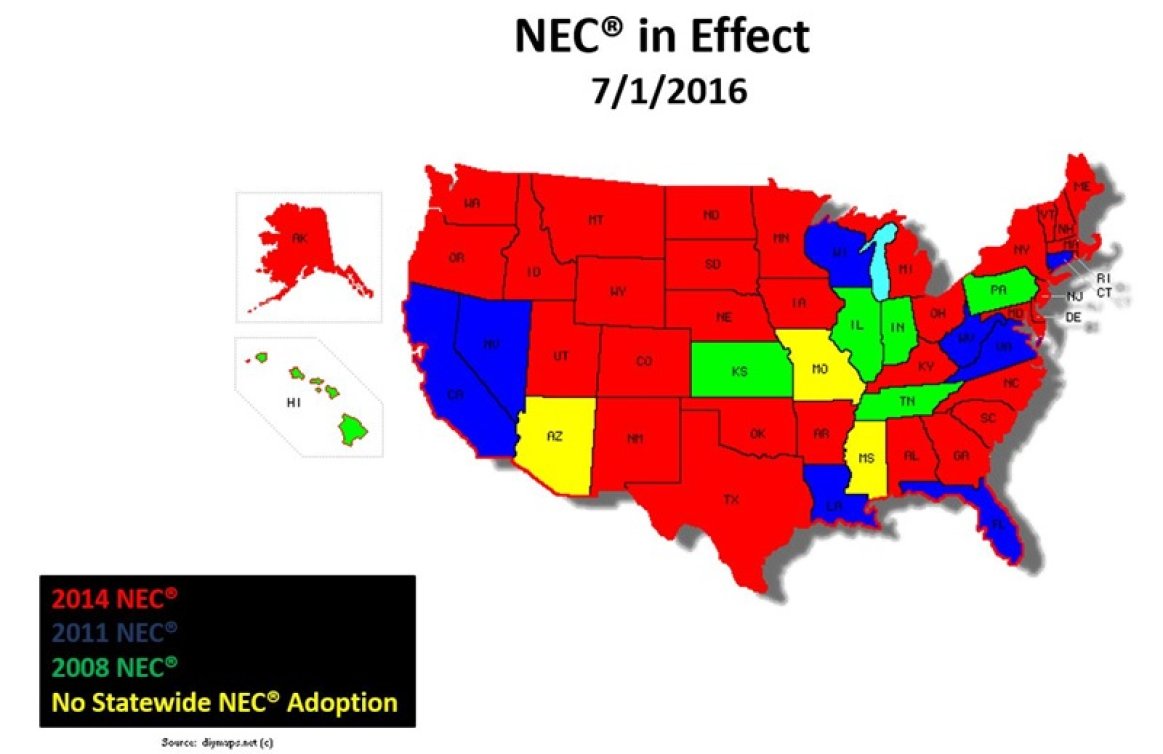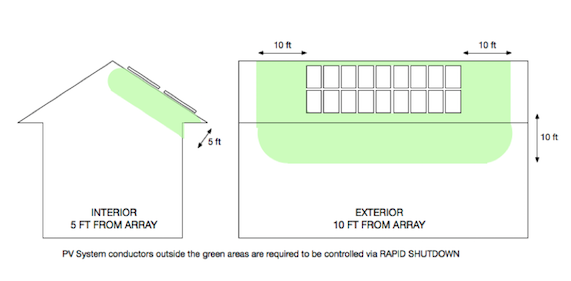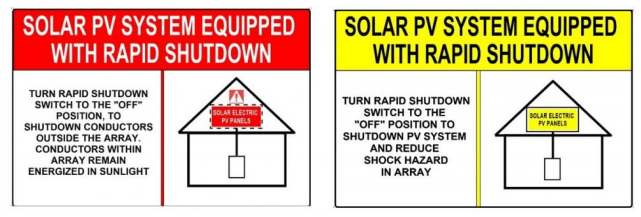
The 2017 Edition of the National Fire Protection Association (NFPA) 70 National Electrical Code (NEC) brings a handful of additions and clarifications to the code pertaining to the permitting and installation of solar PV. These changes will have meaningful impacts on the design criteria of residential and commercial solar installations alike. While NFPA 70 covers best-practice of everything from feeders circuits, to HVAC and fiber optic cable raceways, the code most relevant to solar installations lives in Article 690.
In addition to providing clarification, the new NEC code was developed with concision in mind. Despite building out certain sections (namely rapid shutdown requirements) to provide manufacturers and contractors with increased guidance, overall Article 690 will see a 20% reduction in word count over the 2014 Edition. Although the final draft of NEC 2017 has yet to be signed off by the NFPA, the changes highlighted below are sure to be represented in the final adoption. Please note this is not an exhaustive look at all the solar-relevant code changes coming down the pipe. The following represent changes sure to impact a large majority of solar contractors on the most common installs. Further resources on coming code changes can be found at the end of this article.
Section 690.12 - Rapid Shutdown of PV Systems on Buildings
Rapid shutdown (RS) was formally codified in the 2014 Edition of NFPA 70. This article sought to control conductors beyond a specified distance of the array to ensure first responder safety in the event of a fire-related emergency at a building with solar. As can be seen in the figure below, PV conductors greater than 5 ft in length within the building, and conductors greater than 10ft outside of the building must be limited to no more than 30V and 240 volt-amperes within 10 seconds of rapid shutdown initiation. Rapid shutdown initiation methods must be labeled in a specific manner.

Most notably, NEC 2014 called for rapid shutdown equipment to be listed and identified as serving its named purpose. In keeping with the definition provided by the NFPA, identified allows for the use of existing equipment (contactor combiner) to satisfy RS requirements as long as the equipment’s use is compliant with its stated rating. Seeking to standardize the equipment used in RS systems, NEC 2017 calls for the use of equipment that is listed and labeled. This labeled requirement drives the need for the development of RS-specific product standards. As these standard have yet to be established, listed and labeled RS requirements will not come into enforcement until January 1, 2019. We'll be on the lookout for standardized and certified RS combiners as they hit the market.
NEC 2017 spells out 3 options for RS compliance:
-
Option 1: List and label or field-label PV array as a rapid-shutdown PV array.
-
Option 2: Limit controlled conductors within the array boundary to 80 V or less within 30 seconds of rapid-shutdown initiation.
-
Option 3: Install nonmetallic PV array with no exposed wiring and array more than 8 feet from any grounded metal parts.
Options 2 and 3 will help guide the development of the certifications and standards for the next generation of labeled RS boxes/combiners.
As RS codes evolve so must the labeling of these systems. In a post NEC 2017 adoption world firefighters will face the possibility of encountering three different PV systems; pre-NEC 2014 (no RS), NEC 2014 compliant (conductors de-energized according to the below-left image), and NEC 2017 compliant (PV conductors de-energized at the array, below-right image). To effectively communicate the safety of the array, labels must accurately reflect which conductors will become de-energized after RS initiation. Some sample labels can be found below.

For a more detailed look at PV labeling in NEC 2017 (including but not limited to RS) please see Todd Fries’s article in Solar Power World.
Functionally v. Solidly Grounded
In the US utilities supply grounded AC power to homes and businesses. In practice this means a conductor that would otherwise carry current is purposely not energized and is instead connected solidly to ground. According to Article 100 of the NFPA code a solidly grounded system is one that is “connected to ground without inserting any resistor or impedance device.” Evolution of safety guidelines in the code and technological developments of PV inverters have rendered the solidly grounded requirement somewhat obsolete. First, the advent and ultimate requirement of DC ground fault protection in PV systems led to overcurrent protection (OCP) becoming a part of the system ground connection. A system with OCP on the ground conductor is no longer in accordance with the coded definition of a solidly grounded electrical system. In essence these systems are functionally rather than solidly grounded.
Second, the rise of non-isolated transformerless inverters further pushed the limits of the code by introducing ungrounded electrical systems into the grid. This led to the introduction of Article 690.35, Ungrounded PV Systems in the 2005 Edition of the NEC. With ungrounded and functionally grounded systems becoming the only types of systems installed in the past decade or so, NEC 2017 sought to bring clarity and simplification to contractors and AHJs alike. NEC 2017 introduces the definition of a functionally grounded PV system as one “that has an electrical reference to ground that is not solidly grounded.” Furthermore Article 690.35, Ungrounded PV Systems was removed from NEC 2017.
Together these two changes have a large impact on the design criteria of modern PV systems. Prior to this change two design criteria existed for PV systems. For solidly or functionally grounded PV systems OCPD was required on one leg of a PV circuit. By comparison, ungrounded PV systems required both legs of the PV circuit to have OCP. In recognizing that no new PV system is solidly grounded we can consolidate the design criteria for all new PV systems under NEC 2017. These changes can be summarized as follows;
-
Overcurrent protection is required in only one leg of a PV circuit [690.9(C)]
-
Disconnecting means are required in both legs of a PV circuit [690.15]
-
USE-2 or PV Wire is allowed as single-conductor cable in a PV array [690.31(C)]
In practice this consolidation will simplify system design for new and experienced solar contractors alike. The permitting and inspection of new PV systems will also become more intuitive as both functionally grounded and ungrounded systems will be held to the same standard of OCP. To the relief of many, ungrounded systems that require combiner boxes will no longer require "oversized" boxes to accommodate double the number of fuses as their are PV circuits entering the box. The code changes listed above, in particular 690.15, will also improve the safety of technicians servicing functionally grounded systems. By requiring a means to disconnect both legs of the PV circuit a technician can safely work on a PV system during daylight hours. Finally, the final code change bulleted above, 690.31(C), allows for integrators to replace grounded inverters with new transformerless inverters in an existing system without having to upgrade single conductor wiring (DC disconnects will need to be rewired or most-likely replaced).
PV System Boundaries
To increase serviceability safety and increase clarity NEC 2017 addresses the location of the PV disconnect and introduces new PV system boundaries. Unlike previous NEC editions, NEC 2017 breaks out energy storage and battery-based multimode inverters from the PV system. As energy storage systems become more prevalent in the presence of solar it was deemed necessary to parse out the code covering these components. Moving forward these components will be addressed in their own dedicated articles. As such, the PV disconnect now represents the boundary of the PV system. In standard grid-tied systems the only components located upstream of the PV disconnect include the PV array and inverter(s). This remains the same for systems employing AC modules or microinverters. No longer part of the PV system, battery inverters, batteries and dump loads will be located downstream of the PV system disconnect.
Once again, please keep in mind the proposed changes above are just a small section of the changes to Article 690 in NEC 2017. As can be seen in the table below there are many subtle yet impactful changes sure to be coming in the newest edition of the NEC. Together these changes promise to clarify both the design and permitting process. Stay tuned for more NEC 2017 developments as they arise.

For more information and analysis on upcoming NEC changes please see the following articles: